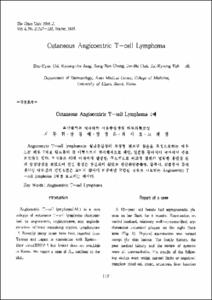뇌출혈로 발현한 척추기저동맥의 동맥경화성 폐색 일례
- Alternative Title
- One Case of Hemorrhagic Stroke of Vertebrobasilar Occlusive Disease
- Abstract
- Background : There have been some reports of intracranial hemorrhage which were attributed to atherosclerotic occlusive disease of major intracranial arteries, mostly the carotid system. The vertebrobasilar system very rarely presents hemorrhage as a result of occlusion or stenosis. We report a case of cerebellar and subarachnoid hemorrhage with vertebrobasilar atherosclerotic occlusion. Case report : A patient with severe vertigo, diplopia and ataxia of sudden onset was managed with intraarterial thrombolytic therapy for the left vertebral artery occlusion. After that, the arterial occlusion and the neurologic deficits resolved rapidly. Four years later, he developed a sudden headache and vertigo. Brain CT revealed right cerebellar hemorrhage with adjacent subarachnoid hemorrhage. Follow-up angiography showed occlusion of the right vertebral artery with fine collateral vessels. Rupture of small collateral vessels secondary to the atherosclerotic occlusion of the distal vertebral artery was postulated as the underlying cause of hemorrhage. Conclusion : Atherosclerotic occlusive disease of the vertebrobasilar system may bring about intracranial hemorrhage just like moyamoya disease does in the carotid system. The same pathomecha-nism seems to play in these clinical situations.
Background : There have been some reports of intracranial hemorrhage which were attributed to atherosclerotic occlusive disease of major intracranial arteries, mostly the carotid system. The vertebrobasilar system very rarely presents hemorrhage as a result of occlusion or stenosis. We report a case of cerebellar and subarachnoid hemorrhage with vertebrobasilar atherosclerotic occlusion. Case report : A patient with severe vertigo, diplopia and ataxia of sudden onset was managed with intraarterial thrombolytic therapy for the left vertebral artery occlusion. After that, the arterial occlusion and the neurologic deficits resolved rapidly. Four years later, he developed a sudden headache and vertigo. Brain CT revealed right cerebellar hemorrhage with adjacent subarachnoid hemorrhage. Follow-up angiography showed occlusion of the right vertebral artery with fine collateral vessels. Rupture of small collateral vessels secondary to the atherosclerotic occlusion of the distal vertebral artery was postulated as the underlying cause of hemorrhage. Conclusion : Atherosclerotic occlusive disease of the vertebrobasilar system may bring about intracranial hemorrhage just like moyamoya disease does in the carotid system. The same pathomecha-nism seems to play in these clinical situations.
- Issued Date
- 1996
- Type
- Research Laboratory
- Alternative Author(s)
- Nam, Byung Kuk; Lee, Jae Hong; Lee, Soon Keum; Lee, Myoung Chong
- Publisher
- 울산의대학술지
- Language
- kor
- Rights
- 울산대학교 저작물은 저작권에 의해 보호받습니다.
- Citation Volume
- 5
- Citation Number
- 1
- Citation Start Page
- 104
- Citation End Page
- 110
- Appears in Collections:
- Research Laboratory > The ULSAN university medical journal
- 파일 목록
-
-
Download
 000002025280.pdf
기타 데이터 / 481.58 kB / Adobe PDF
000002025280.pdf
기타 데이터 / 481.58 kB / Adobe PDF
-
Items in Repository are protected by copyright, with all rights reserved, unless otherwise indicated.